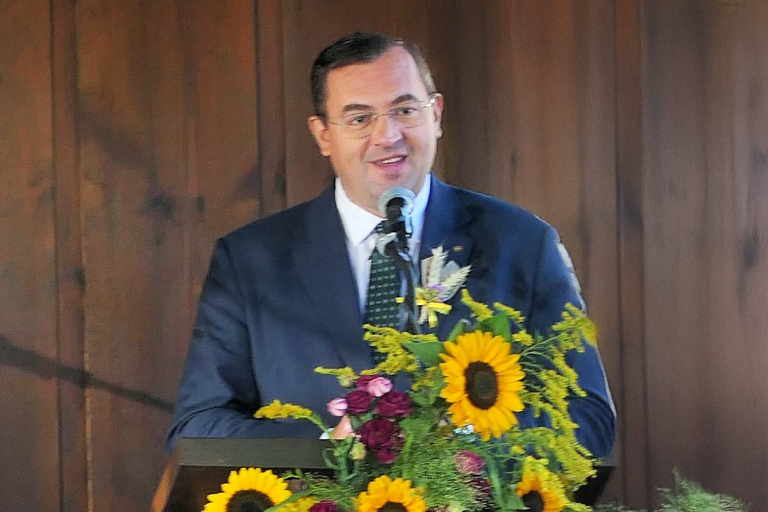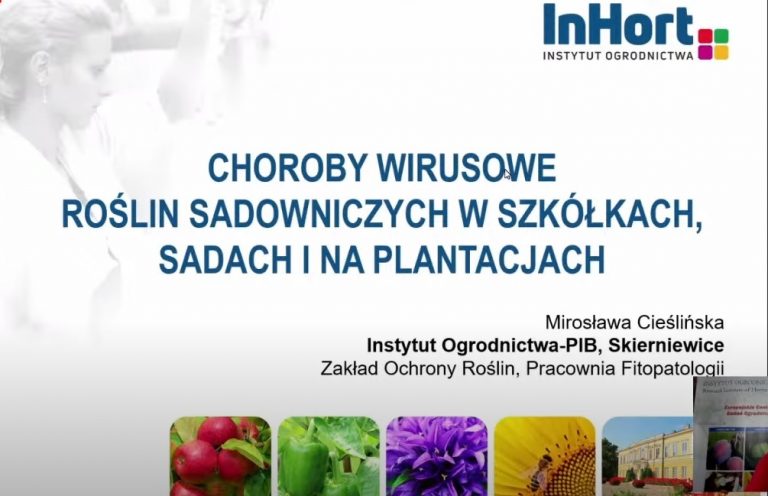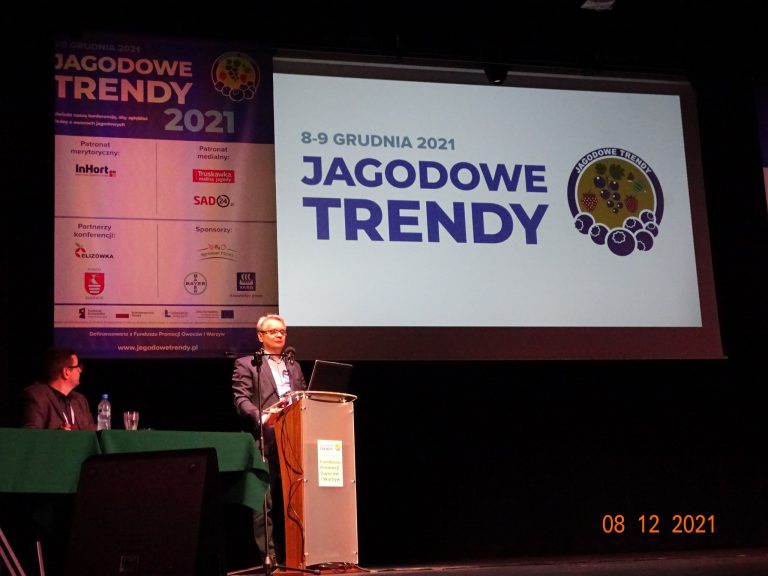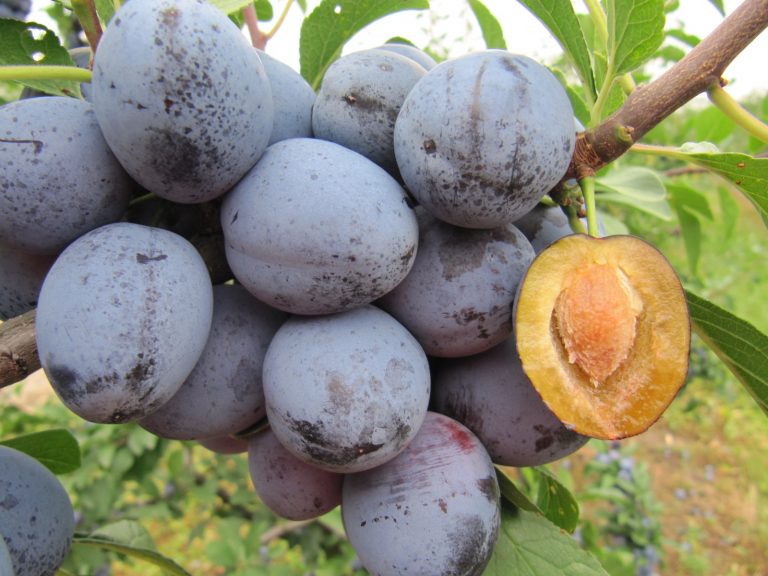
AKTUALNOŚCI
WYDARZENIA
Journal of Horticultural Research 32(1) 2024
Waldemar TREDER, Anna TRYNGIEL-GAĆ, Krzysztof KLAMKOWSKI, Katarzyna WÓJCIK, Wojciech STĘPIEŃ
Variability of air temperature in Skierniewice, Poland, over the period 1923–2022
ABSTRACT
Variability of air temperature in Skierniewice, Poland, over the period 1923–2022
The study aimed to determine the magnitude of changes in air temperature in Skierniewice, Poland, over the last 100 years, with particular emphasis on multi-year variability. The source material for the analyses were air temperature measurements from 1923 to 2022 obtained from the meteorological station in the Experimental Field of the Warsaw University of Life Sciences and the station in the Experimental Orchard of the National Institute of Horticultural Research. The study presents average annual, minimum, and maximum air temperatures along with an assessment of the trend of their multi-year variability. The features of changes in the average air temperature in Skierniewice presented in the study based on a 100-year series of meteorological measurements are characterized by high temporal variability with a clear upward trend. The average warming rate over 100 years was 0.17°C per 10 years, but in the last 60 years it has already reached 0.38°C per 10 years. In the case of the average annual air temperature since 1981, there has been a sequence of years warmer than average throughout the measurement period. The number of summer days (>25°C) and hot days, when the maximum temperature exceeds 30°C, is also increasing. In the analyzed period, the decade 2013–2022 was the warmest
TŁUMACZENIE
Zmienność temperatury powietrza w Skierniewicach, Polska, w latach 1923–2022
Celem badań było określenie wielkości zmian temperatury powietrza w Skierniewicach na przestrzeni ostatnich 100 lat, ze szczególnym uwzględnieniem zmienności wieloletniej. Materiał źródłowy do analiz stanowiły dokumenty z pomiarów temperatury powietrza z lat 1923–2022, pozyskane ze stacji meteorologicznej na Polu Doświadczalnym SGGW oraz stacji w Sadzie Doświadczalnym Instytutu Ogrodnictwa – PIB. W opracowaniu przedstawiono średnie roczne, minimalne i maksymalne temperatury powietrza wraz z oceną trendu ich wieloletniej zmienności. Analiza przebiegu zmian średniej temperatury powietrza w Skierniewicach na podstawie 100-letniej serii pomiarów wykazała dużą zmienność czasową z wyraźnym trendem wzrostowym. Średnie tempo ocieplenia w ciągu 100 lat wyniosło 0,17°C na 10 lat, ale w ostatnich 60 latach osiągnęło już poziom 0,38°C na 10 lat. W przypadku średniej rocznej temperatury powietrza od 1981 roku nastąpiła sekwencja lat cieplejszych niż średnia wartość dla całego okresu pomiarów. Zaobserwowano również wzrost liczby dni letnich (>25°C) oraz dni gorących (z temperaturą maksymalną wyższą od 30°C). W analizowanym okresie najcieplejsza była dekada 2013–2022.
Tatyana STEFANOVSKA, Andrzej SKWIERCZ, Valentina PIDLISNYUK, Vira BORODAY, Artem MEDKOW, Olexander ZHUKOV
Effect of the biostimulants of microbiological origin on the entomopathogenic and plant parasitic nematodes from Miscanthus × giganteus plantations
ABSTRACT
Effect of the biostimulants of microbiological origin on the entomopathogenic and plant parasitic nematodes from Miscanthus × giganteus plantationsroups
This study aimed to evaluate the effect of biostimulants derived from Streptomyces avermitilis metabolites on entomopathogenic nematodes: Steinernema carpocapsae, Steinernema feltiae, and Heterorhabditis bacteriophora, obtained from the soil of several Miscanthus × giganteus plantations in 2020–2023. The nematodes were isolated, identified, and cultured using live insects (the greater wax moth Galleria mellonella). Three preparations containing biostimulants – Charkor, Stimpo, and Regoplant, were tested for compatibility with entomopathogenic and plant parasitic nematodes. Their effect on nematode survival was evaluated using the Petri dish test. The study showed that the effect of biostimulants on the survival of nematodes depended on the concentration of aversectin contained in the evaluated preparations. Stimpo and Regoplant had an adverse effect on plant parasitic nematodes. The highest G. mellonella mortality was observed at the higher dose of Charkor (0.4%), and the lowest at the lower dose of Regoplant (1.22%). The study showed that the virulence of the nematodes decreased after 48 hours of incubation in Regoplant and Stimpo solutions containing aversectin. The degree of interaction between nematodes depended on the nematode species, trophic preferences, and the concentration of active ingredients in the preparations. This conclusion is crucial for the selection of appropriate types of entomopathogenic nematodes and the application rate of plant parasitic nematodes in the assessment of their short- and long-term spread, persistence, and recycling in field conditions.
TŁUMACZENIE
Oddziaływanie biostymulantów pochodzenia mikrobiologicznego na nicienie entomopatogenne i pasożytnicze wyizolowane z gleby na plantacji miskanta olbrzymiego
Celem pracy była ocena wpływu biostymulantów pochodzących z metabolitów Streptomyces avermitilis na entomopatogenne nicienie: Steinernema carpocapsae, Steinernema feltiae oraz Heterorhabditis bacteriophora, wyizolowane z gleby na plantacjach Miscanthus × giganteus w latach 2020–2023. Nicienie hodowano przy użyciu żywych owadów (barciak większy Galleria mellonella). Wpływ na przeżywalność nicieni entomopatogennych i pasożytniczych trzech preparatów – Charkor, Stimpo i Regoplant, zawierających biostymulanty, został zbadany za pomocą testu na płytkach Petriego. W badaniach wykazano, że wpływ biostymulantów na przeżywalność nicieni pasożytniczych zależał od stężenia awersektyny, która była w składzie preparatów Stimpo i Regoplant. Największą śmiertelność G. mellonella zaobserwowano przy wyższej dawce Charkoru (0,4%), natomiast najmniejszą przy niższej dawce Regoplantu (1,22%). Wirulencja nicieni zmniejszyła się już po 48 godzinach inkubacji w roztworach Regoplant i Stimpo. Stopień interakcji między nicieniami zależał od ich gatunku, preferencji troficznych i stężenia składników aktywnych w preparatach. Wniosek ten jest kluczowy dla doboru odpowiednich typów nicieni entomopatogennych i dawki preparatów nicieniobójczych w ograniczaniu nicieni pasożytujących na roślinach oraz dla oceny krótko- i długoterminowego rozprzestrzeniania się nicieni, trwałości i recyklingu w warunkach polowych.
Atta Kwesi AIDOO, Amina DAWOOD, Jerry Fenteng ASAMOAH, Zippora APPIAH-KUBI, Godfried OHENE-MENSAH, Daniel AGBETIAMEH, Felix FRIMPONG, Joseph Nii LAMPTEY, Maxwell KWODANE, Catherine Kofogi KABA
In vitro efficacy of three potential bioagents against Lasiodiplodia theobromae, causal agent of postharvest fruit deterioration of avocado
ABSTRACT
In vitro efficacy of three potential bioagents against Lasiodiplodia theobromae, causal agent of postharvest fruit deterioration of avocadoon estimation using machine learning methods
The postharvest rot fungus, Lasiodiplodia theobromae, poses a significant threat to the avocado trade in Ghana as it discounts both the quality and shelf life of freshly harvested avocado fruits. This study evaluated the biological effect of three bioagents, garlic, baking soda, and black pepper, on mitigating postharvest rots of avocado fruits caused by L. theobromae. Isolates of L. theobromae obtained from spoiled fruits were identified using morphological, molecular, and pathogenicity procedures. Eight isolates of L. theobromae were similar in morphology and pathogenicity and genetic markers (ITS). The three bioagents, garlic and pepper seed powder, and baking soda, were evaluated in vitro using the food poison technique at two concentrations, 10 g and 20 g per 100 ml of water. Garlic at 20 g/100 ml of water completely inhibited mycelium growth, followed with 10 g/l (7.8%), and baking soda at 20 g/l (32.6%). Further studies of these bioagents on fruit are recommended.
TŁUMACZENIE
Ocena skuteczności in vitro trzech biopreparatów przeciwko Lasiodiplodia theobromae, grzybowi powodującemu gnicie owoców awokado po zbiorze
Lasiodiplodia theobromae, grzyb powodujący zgniliznę pozbiorczą, stanowi poważne zagrożenie dla handlu owocami awokado w Ghanie, ponieważ pogarsza zarówno jakość, jak i okres przydatności do spożycia świeżo zebranych owoców. W badaniu oceniano biologiczny wpływ trzech biopreparatów: czosnku, sody oczyszczonej i nasion czarnego pieprzu, na ograniczenie pozbiorczej zgnilizny owoców awokado wywoływanej przez L. theobromae. Izolaty L. theobromae uzyskane z zepsutych owoców zidentyfikowano za pomocą procedur morfologicznych, molekularnych i oceny patogeniczności. Osiem izolatów L. theobromae było podobnych pod względem morfologii, patogeniczności i markerów genetycznych (ITS). Trzy preparaty – proszek z główek czosnku i nasion pieprzu oraz sodę oczyszczoną, oceniano in vitro, stosując dwa stężenia – 10 g i 20 g na 100 ml wody. Czosnek w stężeniu 20 g na 100 ml wody całkowicie hamował wzrost grzybni, następnie 10 g/l (7,8%) i soda oczyszczona w stężeniu 20 g/l (32,6%). Zaleca się dalsze badania tych bioczynników na owocach.
Siddhi CHAVAN, Anil KHATAL, Satish PHALAKE, Sujata TETALI, Ravindra PATIL
Identification and validation of new reference genes for normalization of gene expression in flower and berry developmental stages of interspecific grape hybrid V. vinifera (L.) × V. labrusca (L.)
ABSTRACT
Identification and validation of new reference genes for normalization of gene expression in flower and berry developmental stages of interspecific grape hybrid V. vinifera(L.) × V. labrusca(L.)
In quantitative reverse transcription polymerase chain reaction (qRT-PCR), normalizing target gene expression using a reference gene is an indispensable step to control the variability of RNA extraction yield, RNA integrity, reverse transcription efficiency, and PCR amplification. In the present study, we identified candidate reference genes with stable expression during grapes’ flowering and berry development stages. Ten genes, including ACT, CYP5, RLI, TUB, UBC, UBC17, UBC60, UFD1, VAG, and ZNF with relatively stable expression, were selected based on RNAseq data generated earlier in grape hybrid ‘ARI 516’. The expression of these candidate genes was tested at different stages of flowering and grape berry development. Five different algorithms such as RefFinder, geNorm, NormFinder, BestKeeper, and the comparative ΔCq method were used to test the expression stability of candidate genes. A comprehensive ranking obtained by RefFinder showed that UBC17, RLI, and ZNF were the most stable reference genes during flower and berry development stages. UBC17, RLI, and ZNF were calibrators to normalize the expression of VvAGL11 as a target gene to validate the worthiness of identified reference genes. The result demonstrated that newly identified reference genes could be successfully used to normalize the expression of the target gene accurately. These reference genes will provide more choices for selecting appropriate reference genes to normalize gene expression in grapes.
TŁUMACZENIE
Identyfikacja i walidacja nowych genów referencyjnych dla normalizacji ekspresji genów na różnych etapach rozwoju kwiatów i jagód międzygatunkowego mieszańca Vitis vinifera (L.) × V. labrusca (L.)
W ilościowej reakcji łańcuchowej polimerazy z odwrotną transkrypcją (qRT-PCR) eksperyment normalizacji ekspresji genu docelowego przy użyciu genu referencyjnego jest niezbędnym etapem kontrolującym zmienność wydajności ekstrakcji RNA, integralność RNA, skuteczność reakcji odwrotnej transkrypcji i amplifikacji PCR. W niniejszym badaniu zidentyfikowano kandydujące geny referencyjne o stabilnej ekspresji na etapach kwitnienia i rozwoju owoców. Na podstawie danych RNAseq wygenerowanych wcześniej w mieszańcu winogrona ‘ARI 516’ wybrano dziesięć genów: ACT, CYP5, RLI, TUB, UBC, UBC17, UBC60, UFD1, VAG i ZNF. Ekspresję tych genów kandydujących zbadano na różnych etapach kwitnienia i rozwoju jagód. Do przetestowania stabilności ekspresji genów kandydujących zastosowano pięć różnych algorytmów, takich jak: RefFinder, geNorm, NormFinder, BestKeeper i metoda porównawcza ΔCq. Kompleksowy ranking uzyskany przez RefFinder wykazał, że UBC17, RLI i ZNF były najbardziej stabilnymi genami referencyjnymi na etapach rozwoju kwiatów i jagód, a więc mogły być użyte do kalibrowania ekspresji VvAGL11 (jako genu docelowego) i mogą służyć do sprawdzania przydatności zidentyfikowanych genów referencyjnych. Wynik pokazał, że nowo zidentyfikowane geny referencyjne można z powodzeniem zastosować do dokładnej normalizacji ekspresji genu docelowego.
Masresha MINUYE, Aserse YENASEW, Segedu BELEW
Effect of Drying Method on the Nutritional and Antioxidant Properties of Mango, Avocado, and Tomato
ABSTRACT
Effect of drying method on the nutritional and antioxidant properties of mango, avocado, and tomato
The present study aims to evaluate nutrient retention in mango, avocado, and tomato dried using freezing, refractance windows, and oven methods. The quality parameters of the dried products were assessed, such as color, water activity, and antioxidant content. Greater color retention was observed for freeze-dried products than for products dried using other methods. All products showed low water activity (>0.4), which prevented microbial growth. Freeze-dried products had the highest content of lycopene and carotenoids. Instead, more flavonoids and phenolics were detected in the refractance window method and then in the oven-dried products. Although freeze-dried products are preferred, the refractance windows method could be a promising drying technology because of its energy savings, easy operations, and low cost.
TŁUMACZENIE
Wpływ metody suszenia na właściwości odżywcze i przeciwutleniające mango, awokado i pomidora
Celem niniejszego badania była ocena retencji składników odżywczych owoców mango, awokado i pomidora, które suszono metodami zamrażania, okna refrakcji i termiczną. Oceniono parametry jakościowe suszu, takie jak barwa, aktywność wody i zawartość przeciwutleniaczy. W przypadku produktów liofilizowanych zaobserwowano większą trwałość koloru niż w przypadku produktów suszonych innymi metodami. Wszystkie produkty wykazały niską aktywność wody (>0,4), co zapobiegało rozwojowi drobnoustrojów. Największą zawartość likopenu i karotenoidów stwierdzono w produktach liofilizowanych. Natomiast więcej flawonoidów i fenoli wykryto w owocach suszonych metodą okna refrakcji, a następnie w produktach suszonych w piecu. Chociaż preferowane były produkty liofilizowane, metoda okna refrakcyjnego może być obiecującą technologią suszenia, ze względu na oszczędność energii, łatwą obsługę i niski koszt.
A.S.M. Mesbah UDDIN, Joydeb GOMASTA, Md. Torikul ISLAM, Monirul ISLAM, Emrul KAYESH, Mohammad R. KARIM
Gibberellic acid spray modulates fruiting, yield, quality, and shelf life of rambutan (Nephelium lappaceum L.)
ABSTRACT
Gibberellic acid spray modulates fruiting, yield, quality, and shelf life of rambutan (Nephelium lappaceum L.)
A lucrative and delicious nonclimacteric tropical fruit, rambutan, has disadvantages of inadequate fruiting, low yield, and inferior edibility at farm level that need to be addressed. Moreover, unstable tropical temperatures and humidity threaten poor fruit set and insufficient rambutan yields. Therefore, the study revealed the effectiveness of gibberellic acid (GA3) on fruit set and retention, fruit size and yield, shelf life, and postharvest properties of rambutan under these atmospheric conditions. GA3 at concentrations of 50, 100, 200, 300, 400, and 500 ppm, apart from the control (without GA3), was applied to panicles twice in the early flowering and the early fruiting stages (thirty days after the first spraying). The results showed that maximum fruit set (223.2 per panicle), retention (13.2 per panicle, 5.9%), and yield (714.0 g per panicle) were obtained by GA3 treatment at 300 ppm. In addition to increasing fruit size (54.1 g) and pulp weight (31.3 g), GA3 at a dose of 300 ppm significantly reduced seed weight by 27.5% and increased the edible portion by 26.6% compared to the control. Notably, preharvest GA3 treatment increased TSS content (19.0%), total sugar (4.5%), and shelf life (11.5 days), while it decreased titratable acidity (0.4%) of rambutan. GA3 doses from 200 to 500 ppm had similar effects in terms of affecting the edible properties and shelf life of rambutan. However, fruit set, retention, and yield exhibited distinct dose-dependent responses, with 300 ppm being the best and 200 ppm consistent with the best, with some differences. Regression analysis showed a skewed curve explaining higher yield and better fruit quality at the medium GA3 treatment level (250–350 ppm). In comparison, lower (< 200 ppm) and higher (> 400 ppm) doses resulted in worse results in most cases. Therefore, regulated use of GA3 is necessary to improve rambutan yield and fruit quality.
TŁUMACZENIE
Oprysk kwasem giberelinowym wpływa na owocowanie, plonowanie oraz jakość i okres przydatności do spożycia owoców rambutanu (Nephelium lappaceum L.)
Uprawa rambutanu jest ryzykowna z powodu niedostatecznego zawiązywania owoców, niskich plonów i niewysokich właściwości jadalnych. Niestabilne tropikalne temperatury i wilgotność powodują słabe zawiązywanie owoców i niewystarczające plony. Badanie ujawniło pozytywny wpływ kwasu giberelinowego (GA3) na zawiązywanie i wielkość owoców oraz ich plon i okres przydatności do spożycia oraz jakość owoców rambutanu. GA3 w stężeniach 50, 100, 200, 300, 400 i 500 ppm w formie oprysku na wiechy zastosowano dwukrotnie: we wczesnej fazie kwitnienia i wczesnej fazie owocowania (trzydzieści dni po pierwszym oprysku). Wyniki wykazały, że maksymalne zawiązanie owoców (223,2 na wiechę), retencję (13,2 na wiechę, 5,9%) i plon (714,0 g na wiechę) uzyskano przy podaniu GA3 w stężeniu 300 ppm. Oprócz zwiększenia masy owoców (54,1 g) i masy miąższu (31,3 g), GA3 w stężeniu 300 ppm wpływał znacząco na zmniejszenie masy nasion o 27,5% i zwiększenie części jadalnej o 26,6% w porównaniu z kontrolą (oprysk wodą). Zastosowanie GA3 wpłynęło również na zwiększenie zawartości TSS (19,0%) i cukru całkowitego (4,5%) w owocach, wydłużeniu okresu przydatności do spożycia (11,5 dnia), a także na obniżenie kwasowości miareczkowej (0,4%). Roztwory GA3 w stężeniu od 200 do 500 ppm wykazywały podobny wpływ na właściwości smakowe i trwałość owoców rambutanu. Zawiązywanie owoców, ich trwałość i plon były zależne od stężenia, przy czym najkorzystniejsze było 300 ppm, a 200 ppm nieco mniej. Analiza regresji wykazała wyższą wydajność i lepszą jakość owoców przy średnim stężeniu GA3 (250–350 ppm). Dla porównania niższe i wyższe stężenia w większości przypadków powodowały obniżenie wydajności i cech owocu. Dlatego regulowane stosowanie GA3 jest konieczne, aby poprawić plonowanie i jakość owoców rambutanu.
Tran Thi Phuong NHUNG, Le Pham Tan QUOC
Evaluation of the effectiveness of Millettia pachyloba Drake leaf ethanol extract in alleviating oxidative stress induced by diamondback moth infestation in mustard greens [Brassica juncea (L.) Czern. & Coss.]
ABSTRACT
Evaluation of the effectiveness of Millettia pachyloba Drake leaf ethanol extract in alleviating oxidative stress induced by diamondback moth infestation in mustard greens [Brassica juncea (L.) Czern. & Coss.]
The global threat that the diamondback moth (DBM) (Plutella xylostella) poses to Brassica juncea creates an urgent need to develop effective mitigation strategies. With promising findings, this study explores the potential of plant-derived antioxidants, particularly Millettia pachyloba, in mitigating DBM-induced oxidative stress. Greenhouse experiments conducted using M. pachyloba leaf ethanol extract (MPEE) at concentrations of 2, 4, 6, 8, and 10% (w/v) showed the inhibitory effect of MPEE on DBM damage in B. juncea. The comprehensive assessment included the effectiveness of MPEE in reducing oxidative stress markers (malondialdehyde, hydrogen peroxide), augmenting metabolites (flavonoids, phenolics), enhancing anti-oxidant compounds (glutathione, ascorbic acid, total protein), and stimulating key enzymes (superoxide dismutase, catalase, and ascorbate peroxidase). The results were compared to controls, in which the plants were treated with water or fipronil. Fipronil and MPEE significantly reduced leaf puncturing and damage, and the impact force increased with MPEE concentration. Both types of protection reduced the content of malondialdehyde and hydrogen peroxide in leaves, stems, and roots. However, a significant increase in the content of flavonoids, phenolic and antioxidant compounds (glutathione, ascorbic acid, and proteins) and enzyme activity (superoxide dismutase, ascorbate peroxidase, and catalase) was observed. The enhancement of metabolites, enzymes, and antioxidants was comparable in plants treated with fipronil and MPEE 10%. This study, with its potential to replace synthetic fipronil with M. pachyloba extracts to reduce oxidative stress induced by Plutella xylostella on mustard plants, offers a promising solution for protection against this insect.
TŁUMACZENIE
Ocena skuteczności ekstraktu etanolowego z liści Millettia pachyloba w łagodzeniu stresu oksydacyjnego gorczycy sarepskiej [Brassica juncea (L.) Czern.& Coss.), wywoływanego inwazją tantnisia krzyżowiaczka (Plutella xylostella)
Tantniś krzyżowiaczek (Plutella xylostella) stanowi globalny problem w uprawach Brassica juncea, co powoduje pilną potrzebę opracowania skutecznych strategii zwalczania. W tym doświadczeniu oceniono możliwość łagodzenia stresu oksydacyjnego wywołanego przez żerowanie tego owada. W doświadczeniu szklarniowym zastosowano ekstrakt etanolowy z liści Millettia pachyloba w stężeniach 2, 4, 6, 8 i 10% (w/v), aby ocenić jego działanie na szkody powodowane przez owada na B. juncea. Kompleksowa ocena objęła skuteczność ekstraktu w zmniejszaniu stresu oksydacyjnego (na podstawie markerów dialdehydu malonowego i nadtlenku wodoru), w zwiększaniu ilości flawonoidów i związków fenolowych, we wzmacnianiu związków przeciwutleniających (glutation, kwas askorbinowy, białko całkowite) i w stymulacji kluczowych enzymów (dysmutaza ponadtlenkowa, katalaza, peroksydaza askorbinianowa). Wyniki porównano z kontrolą, w której rośliny traktowano wodą lub fipronilem. Zastosowanie etanolowych ekstraktów M. pachyloba znacznie zmniejszyło uszkodzenia liści, a skuteczność rosła wraz ze stężeniem ekstraktu. Zastosowanie fipronilu i ekstraktu wpłynęło na zmniejszenie stężenia dialdehydu malonowego i nadtlenku wodoru w liściach, łodygach i korzeniach. Nastąpił znaczny wzrost stężenia flawonoidów i związków fenolowych, związków przeciwutleniających oraz aktywności enzymów. Działanie fipronilu i ekstraktu w stężeniu 10% było porównywalne. Niniejsze badanie wskazuje na możliwość zastąpienia syntetycznego fipronilu ekstraktem etanolowym z liści M. pachyloba w zmniejszeniu stresu oksydacyjnego wywoływanego przez P. xylostella na gorczycy, a tym samym bezpieczniejszej ochrony przed tym owadem.
Joanna SZUMIGAJ-TARNOWSKA, Wojciech SZCZECHURA
Phenotypic characteristics, pathogenicity, and molecular identification of Hypomyces perniciosus causing wet bubble disease of edible mushrooms
ABSTRACT
Phenotypic characteristics, pathogenicity, and molecular identification of Hypomyces perniciosus causing wet bubble disease of edible mushrooms
The research aimed to determine the phenotypic characteristic, pathogenicity and molecular characterization of Hypomyces perniciosus isolates responsible for wet bubble disease of the white button mushroom Agaricus bisporus. Phenotypic characteristics such as colony appearance, mycelium texture, and pigmentation were studied on four different agar media, i.e., potato dextrose agar (PDA), malt extract agar (MEA), Czapek-Dox yeast agar (CYA), and Sabouraud dextrose agar (SDA), after eight days of incubation. Additionally, the growth rate of the tested isolates was studied depending on the pH of the medium. Fungal isolates showed the highest mycelial growth on MEA and SDA at pH 6.0. However, on CYA at pH 7.0, the mycelium exhibited the worst growth. Isolate identification and genetic relationship analysis were carried out using internal transcribed spacer region sequencing and the random amplified polymorphic DNA method. The research confirmed that all Polish isolates belong to the species H. perniciosus, and the genetic diversity is relatively low. Phylogenetic analyses revealed three subgroups of H. perniciosus isolates. The first group included three genetically distinct isolates with a similarity coefficient in the range of 0.76–0.85 to isolates CBS 815.73 and CBS 322.52. The second group was divided into two subgroups and included 16 isolates with a genetic similarity range of 0.91 to 1.0 to CBS 815.73 and CBS 322.52 isolates. Furthermore, the eight genetically similar isolates exhibited the greatest pathogenicity towards A. bisporus.
TŁUMACZENIE
Charakterystyka fenotypowa, patogeniczność oraz identyfikacja molekularna grzyba Hypomyces perniciosus powodującego mokrą zgniliznę pieczarki
Celem badań była identyfikacja molekularna oraz ocena cech fenotypowych i patogeniczności izolatów Hypomyces perniciosus, odpowiedzialnych za białą zgniliznę w uprawie pieczarki. Cechy fenotypowe grzybów, takie jak morfologia kolonii, kształt, wielkość, powierzchnia, struktura i pigmentacja, badano po 8 dniach wzrostu na czterech różnych podłożach agarowych, tj. agarze ziemniaczanym z dekstrozą (PDA), agarze z ekstraktem słodowym (MEA), agarze drożdżowym Czapek-Doxa (CYA) i agarze dekstrozowym Sabourauda (SDA). Badano także szybkość wzrostu grzybni w zależności od pH podłoża. Badane izolaty wykazały najlepszy wzrost na podłożu MEA i SDA przy pH 6,0, natomiast najgorszy wzrost stwierdzono na CYA przy pH 7,0. Identyfikację i analizę molekularną izolatów przeprowadzono przy użyciu sekwencjonowania regionu ITS (internal transcribed spacer) oraz metody RAPD (random amplified polymorphic DNA). Badania potwierdziły, że wszystkie polskie izolaty należą do gatunku H. perniciosus, a ich zróżnicowanie genetyczne jest stosunkowo niewielkie. Analiza filogenetyczna ujawniła obecność trzech grup izolatów H. perniciosus. Do pierwszej grupy zaliczono trzy izolaty, które różniły się genetycznie od pozostałych, a współczynnik ich podobieństwa do izolatów referencyjnych CBS 815,73 i CBS 322,52 był w zakresie od 0,76 do 0,85. Druga grupa (podzieloną na dwie podgrupy) obejmowała 16 izolatów o współczynniku podobieństwa genetycznego do izolatów referencyjnych w zakresie od 0,91 do 1,0. Największą patogeniczność w stosunku do pieczarki wykazywało osiem genetycznie podobnych izolatów.
Halyna SLOBODIANYK, Andrii TERNAVSKYI, Iryna SMETANSKA, Ihor KRYKUNOV, Liliia VOIEVODA, Nataliia HNATIUK, Sviatoslav SUKHANOV, Vira BORODAY, Julia HELFERT, Volodymyr VOITSEKHIVSKYI
Morphophysiological parameters and leek seed production depending on Fulvohumin treatment and date of planting seedlings
ABSTRACT
Morphophysiological parameters and leek seed production depending on Fulvohumin treatment and date of planting seedlings
Producing leek seeds without replanting one-year-old plants is cheaper and more practical, but can be risky in climates with cold winters. This research aimed to assess whether accelerating the planting of seedlings and using Fulvohumin fertilizer, containing, among others, humic acids can make such production less risky. Three dates were used for planting leek seedlings: April 10, April 25, and May 10. Fulvohumin was used presowing, foliarly, and both. Both factors significantly improved seed production. The best results were obtained at the earliest planting date, as the plants were strong and best prepared for the generative phase and the frost period. Fulvohumin significantly improved growth and development parameters, mainly when used before sowing and as foliar application. In the best combination, with two applications of fertilizers, the seed yield increased by 39%, compared to the control (without Fulvohumin fertilization), and the seed yield of plants planted on April 10 was 17% higher compared to plants planted on April 25 (considered as standard) and 39% higher than those planted on May 10. Seed yield varied in the three subsequent years of the study, but each year, the planting date and Fulvohumin had a similar effect on seed yield.
TŁUMACZENIE
Parametry morfofizjologiczne i produkcja nasion pora w zależności od zastosowania Fulvohuminu i terminu sadzenia
Produkcja nasion pora bez przesadzania jednorocznych roślin jest łatwiejsza, ale może być ryzykowna w klimacie o mroźnych zimach. Celem badań było sprawdzenie, czy przyspieszenie wysiewu i stosowanie nawozu Fulvohumin (zawierającego m.in. kwasy humusowe) może zmniejszyć to ryzyko. Zastosowano trzy terminy sadzenia: 10 kwietnia, 25 kwietnia i 10 maja. Fulvohumin stosowano przedsiewnie na nasiona, dolistnie oraz przedsiewnie i dolistnie. Istotny wpływ na plon nasion miał zarówno termin sadzenia, jak i Fulvohumin. Najlepsze rezultaty uzyskano przy najwcześniejszym terminie sadzenia, gdyż uzyskano mocne rośliny, najlepiej przygotowane do przetrwania mrozów i do formowania organów generatywnych. Fulvohumin znacząco poprawiał parametry wzrostu i rozwoju roślin, zwłaszcza przy łącznym stosowaniu przedsiewnym i dolistnym, kiedy plon nasion wzrósł o 39% w porównaniu do kontroli. Plon nasion z roślin sadzonych 10 kwietnia był o 17% wyższy niż posadzonych 25 kwietnia (ten termin uznaje się za standardowy) i o 39% wyższy niż z roślin sadzonych 10 maja. W trzech kolejnych latach badań plon nasion był zróżnicowany, jednak każdego roku wpływ terminu sadzenia i Fulvohuminu na plon nasion był podobny.









